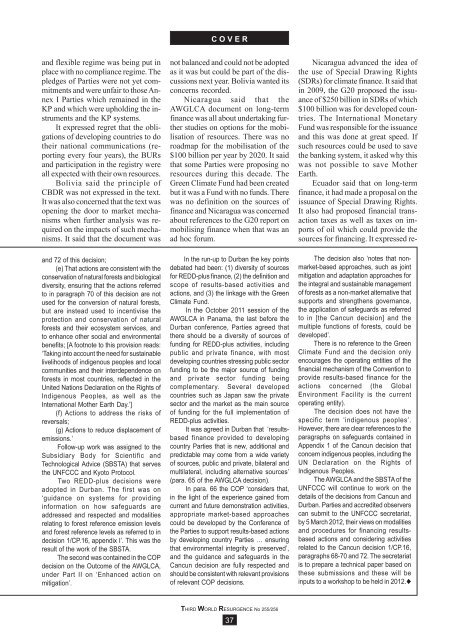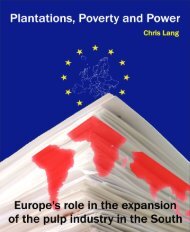Download - Third World Network
Download - Third World Network
Download - Third World Network
You also want an ePaper? Increase the reach of your titles
YUMPU automatically turns print PDFs into web optimized ePapers that Google loves.
C O V E Rand flexible regime was being put inplace with no compliance regime. Thepledges of Parties were not yet commitmentsand were unfair to those AnnexI Parties which remained in theKP and which were upholding the instrumentsand the KP systems.It expressed regret that the obligationsof developing countries to dotheir national communications (reportingevery four years), the BURsand participation in the registry wereall expected with their own resources.Bolivia said the principle ofCBDR was not expressed in the text.It was also concerned that the text wasopening the door to market mechanismswhen further analysis was requiredon the impacts of such mechanisms.It said that the document wasNicaragua advanced the idea ofthe use of Special Drawing Rights(SDRs) for climate finance. It said thatin 2009, the G20 proposed the issuanceof $250 billion in SDRs of which$100 billion was for developed countries.The International MonetaryFund was responsible for the issuanceand this was done at great speed. Ifsuch resources could be used to savethe banking system, it asked why thiswas not possible to save MotherEarth.Ecuador said that on long-termfinance, it had made a proposal on theissuance of Special Drawing Rights.It also had proposed financial transactiontaxes as well as taxes on importsof oil which could provide thesources for financing. It expressed reand72 of this decision;(e) That actions are consistent with theconservation of natural forests and biologicaldiversity, ensuring that the actions referredto in paragraph 70 of this decision are notused for the conversion of natural forests,but are instead used to incentivise theprotection and conservation of naturalforests and their ecosystem services, andto enhance other social and environmentalbenefits; [A footnote to this provision reads:‘Taking into account the need for sustainablelivelihoods of indigenous peoples and localcommunities and their interdependence onforests in most countries, reflected in theUnited Nations Declaration on the Rights ofIndigenous Peoples, as well as theInternational Mother Earth Day.’](f) Actions to address the risks ofreversals;(g) Actions to reduce displacement ofemissions.’Follow-up work was assigned to theSubsidiary Body for Scientific andTechnological Advice (SBSTA) that servesthe UNFCCC and Kyoto Protocol.Two REDD-plus decisions wereadopted in Durban. The first was on‘guidance on systems for providinginformation on how safeguards areaddressed and respected and modalitiesrelating to forest reference emission levelsand forest reference levels as referred to indecision 1/CP.16, appendix I’. This was theresult of the work of the SBSTA.The second was contained in the COPdecision on the Outcome of the AWGLCA,under Part II on ‘Enhanced action onmitigation’.not balanced and could not be adoptedas it was but could be part of the discussionsnext year. Bolivia wanted itsconcerns recorded.Nicaragua said that theAWGLCA document on long-termfinance was all about undertaking furtherstudies on options for the mobilisationof resources. There was noroadmap for the mobilisation of the$100 billion per year by 2020. It saidthat some Parties were proposing noresources during this decade. TheGreen Climate Fund had been createdbut it was a Fund with no funds. Therewas no definition on the sources offinance and Nicaragua was concernedabout references to the G20 report onmobilising finance when that was anad hoc forum.In the run-up to Durban the key pointsdebated had been: (1) diversity of sourcesfor REDD-plus finance, (2) the definition andscope of results-based activities andactions, and (3) the linkage with the GreenClimate Fund.In the October 2011 session of theAWGLCA in Panama, the last before theDurban conference, Parties agreed thatthere should be a diversity of sources offunding for REDD-plus activities, includingpublic and private finance, with mostdeveloping countries stressing public sectorfunding to be the major source of fundingand private sector funding beingcomplementary. Several developedcountries such as Japan saw the privatesector and the market as the main sourceof funding for the full implementation ofREDD-plus activities.It was agreed in Durban that ‘resultsbasedfinance provided to developingcountry Parties that is new, additional andpredictable may come from a wide varietyof sources, public and private, bilateral andmultilateral, including alternative sources’(para. 65 of the AWGLCA decision).In para. 66 the COP ‘considers that,in the light of the experience gained fromcurrent and future demonstration activities,appropriate market-based approachescould be developed by the Conference ofthe Parties to support results-based actionsby developing country Parties … ensuringthat environmental integrity is preserved’,and the guidance and safeguards in theCancun decision are fully respected andshould be consistent with relevant provisionsof relevant COP decisions.The decision also ‘notes that nonmarket-basedapproaches, such as jointmitigation and adaptation approaches forthe integral and sustainable managementof forests as a non-market alternative thatsupports and strengthens governance,the application of safeguards as referredto in [the Cancun decision] and themultiple functions of forests, could bedeveloped’.There is no reference to the GreenClimate Fund and the decision onlyencourages the operating entities of thefinancial mechanism of the Convention toprovide results-based finance for theactions concerned (the GlobalEnvironment Facility is the currentoperating entity).The decision does not have thespecific term ‘indigenous peoples’.However, there are clear references to theparagraphs on safeguards contained inAppendix 1 of the Cancun decision thatconcern indigenous peoples, including theUN Declaration on the Rights ofIndigenous Peoples.The AWGLCA and the SBSTA of theUNFCCC will continue to work on thedetails of the decisions from Cancun andDurban. Parties and accredited observerscan submit to the UNFCCC secretariat,by 5 March 2012, their views on modalitiesand procedures for financing resultsbasedactions and considering activitiesrelated to the Cancun decision 1/CP.16,paragraphs 68-70 and 72. The secretariatis to prepare a technical paper based onthese submissions and these will beinputs to a workshop to be held in 2012.uTHIRD WORLD RESURGENCE No 255/25637















